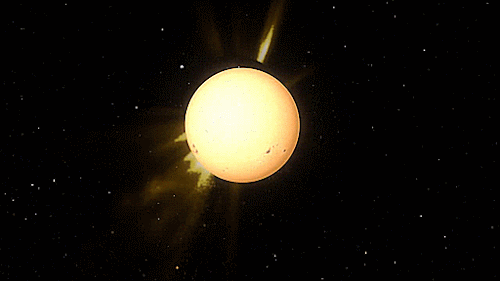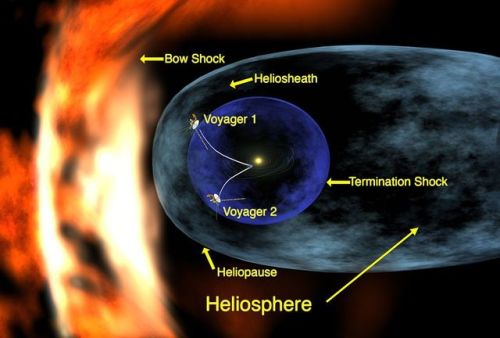I Am On Pillowfort If My Blog Disappears Tomorrow.
I am on Pillowfort if my blog disappears tomorrow.
sharkspaceengine on Pillowfort.
I doubt my blog with disappear, but just in case, the link is above. BTW I am participating in the Tumblr boycott, so I will be back on Tuesday.
More Posts from Sharkspaceengine and Others
Lunar Rings


Pictures of the Day - October 21, 2018
Normally, giant planets are the ones with rings, but in some situations a moon of a gas giant can have its own rings. Here we come across such a satellite.

Picture of the day - December 18, 2018
Polar vortex over the northern pole of Insight A-II




The heliosphere is the bubble-like region of space dominated by the Sun, which extends far beyond the orbit of Pluto. Plasma “blown” out from the Sun, known as the solar wind, creates and maintains this bubble against the outside pressure of the interstellar medium, the hydrogen and helium gas that permeates the Milky Way Galaxy. The solar wind flows outward from the Sun until encountering the termination shock, where motion slows abruptly. The Voyager spacecraft have explored the outer reaches of the heliosphere, passing through the shock and entering the heliosheath, a transitional region which is in turn bounded by the outermost edge of the heliosphere, called the heliopause. The shape of the heliosphere is controlled by the interstellar medium through which it is traveling, as well as the Sun and is not perfectly spherical. The limited data available and unexplored nature of these structures have resulted in many theories. The word “heliosphere” is said to have been coined by Alexander J. Dessler, who is credited with first use of the word in the scientific literature.
On September 12, 2013, NASA announced that Voyager 1 left the heliopause on August 25, 2012, when it measured a sudden increase in plasma density of about forty times. Because the heliopause marks one boundary between the Sun’s solar wind and the rest of the galaxy, a spacecraft such as Voyager 1 which has departed the heliosphere, can be said to have reached interstellar space. source






Pictures of the day - December 2, 2018
Insight System - Third Planet orbiting Insight B (Insight B-III)
Insight B-III is the giant of the Insight System, being the most massive planet of both of the system’s stars. It is a massive gas giant the nears the boundary with a brown dwarf at 11.75 Jupiter masses. The planet has an active atmosphere from both solar heating and internally released heat and has an average atmospheric temperature of 147 F.
The planet orbits the sun at an average distance of 0.21 AU, and completes an orbit once every 41.33 days. The planet is not quite tidally locked with a rotational rate of 41.67 days vs its orbital period of 41.33 days. As a result, a solar day on the planet lasts 14.00 Earth years.
No major satellites orbit the planet; however, 30 asteroid-like irregular satellites orbit the planet.
Note the star visible in the last picture is the Insight System’s primary star Insight A. Viewed from the gas giant, the star shines with an average magnitude of -17.29, bright enough that it illuminates the dark side of objects to approximately the same level of lighting as the average living room.
High Resolution Pictures
Insight B-III
Polar View
Crescent View
Equatorial Cloud Bands
Nearby asteroid moon
Distant asteroid moon

Water ice clouds on Mars (desktop/laptop) Click the image to download the correct size for your desktop or laptop in high resolution

The shadow of a moon's eclipse is visible across this gas giant’s rings.

For scientists watching the Red Planet from our orbiters, the past month has been a windfall. “Global” dust storms, where a runaway series of storms create a dust cloud so large they envelop the planet, only appear every six to eight years (that’s 3-4 Mars years). Scientists still don’t understand why or how exactly these storms form and evolve.
Read the full story HERE.
Make sure to follow us on Tumblr for your regular dose of space: http://nasa.tumblr.com.

First Post.
A low sun on a Mars-like planet overlooking a large canyon.




Pictures of the day - November 24, 2018
Venus-like world with two moons in orbit. I had to use the editor in Space Engine to get a true Venus-Like appearance for this world.
I am not a fan of how some of the planets appear in the game, luckily an editor is provided in order to make some of these worlds appear more realistic.
Space Engine System ID: RS 5581-42-1-2-487 2
High Resolution Pictures
Venus Analog
Two moons
Stormy planet
Closeup
-
 azrael-fallen liked this · 6 years ago
azrael-fallen liked this · 6 years ago -
 bunsandsharks reblogged this · 6 years ago
bunsandsharks reblogged this · 6 years ago -
 sharkspaceengine reblogged this · 6 years ago
sharkspaceengine reblogged this · 6 years ago
My Space Engine Adventures, also any space related topic or news. www.spaceengine.org to download space engine. The game is free by the way. Please feel free to ask me anything, provide suggestions on systems to visit or post any space related topic.Check out my other blog https://bunsandsharks.tumblr.com for rabbit and shark blog.
294 posts
